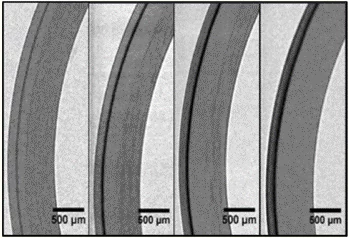During operation in a nuclear reactor, zirconium based fuel cladding tubes take up a part of the hydrogen produced by the oxidation reaction between the reactor coolant water and the hot tube surface. The absorbed hydrogen, depending on concentration and temperature, in solid solution or as zirconium hydrides can be deleterious.
The high spatial resolution of the neutron imaging detectors at PSI combined with the high sensitivity of neutron imaging for hydrogen is instrumental for quantification of hydrogen concentration in nuclear fuel claddings (sub-10 μm spatial resolution and sub-10 wppm concentration resolution).
The current work focusses on the assessment of the nuclear fuel cladding tubes exposed in real conditions of Swiss nuclear power plants [1] (PhD project of Mr O. Yetik, PSI).
Examples of Publications
1. Trtik P., Zubler R., Gong W., Grabherr R., Bertsch J., Duarte L.I., Rev. Sci. Instr. (2020) 2. Gong W., Trtik P., Colldeweih A.W., Duarte L.I., Grosse M., Lehmann E.H., Bertsch J., J. Nucl. Mater. (2019)
3. Gong W., Trtik P., Valance S., Bertsch J., J. Nucl. Mater. (2018)
Collaboration
- Nuclear Fuel Group, PSI, Switzerland
Associated Junior Researchers
Mr Okan Yetik, okan.yetik@psi.ch, +41 56 310 4534
Funding
PSI CROSS – project 'NEUHERA'
Contact
Dr. J. Bertsch, johannes.bertsch@psi.ch, +41 56 310 4173 Dr. L. Duarte, liliana.duarte@psi.ch, +41 56 310 2115 Assoc. Prof. Dr. P. Trtik, pavel.trtik@psi.ch, +41 56 310 5579


